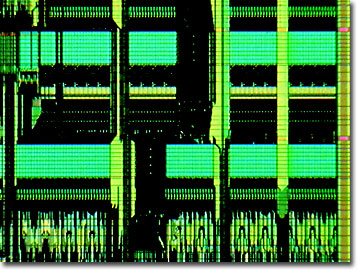Integrated Circuit Image Gallery
Pentium Processor
Representing the fifth generation of Intel microprocessors, the 64-bit Pentium, code-named the P5 during development, succeeded the widely renowned 80486 chip in 1993. With 3.1 million transistors and super-scalar architecture, the Pentium provided five times the performance of the 33 MHz clock speed 486DX in the initial 60 and 66 MHz versions. Even from the initial designs, the Pentium was geared towards a tremendous amount of memory capability with 4 Gbytes of addressable memory and 64 Tbytes of virtual memory. Using 0.8-micron photolithography techniques to fabricate the 262-square-millimeter processor, the Pentium rapidly gained momentum shortly after its initial release. Ultimately, the Pentium and its descendents have become the most scrutinized microprocessor group in history.

View a second image of the Pentium.
With the ability to complete two instructions simultaneously in the dual 486-type integer pipelines with dependency checking and a single, onboard floating-point unit (FPU), the original Pentium featured separate 8-Kbyte instruction and data caches, and greatly enhanced 486-performance. Following the introduction of MMX (known as MultiMedia extensions or Matrix Math extensions) instruction set enhancements, the original Pentium was renamed the Pentium Classic. As the techniques improved in bipolar combined metal oxide semiconductor (BiCMOS) silicon fabrication, the chips' linewidths were rescaled down to 0.6 microns and then to 0.35 microns. Simultaneously, the microprocessors increased from 75 MHz (released 1994) to 200 MHz (released 1996) in clock speed, and their power consumption decreased from the original 5 volts down to 3.3 volts in the newer P54C chips. At the same time the number of transistors onboard escalated to 3.2 million. The Pentium Classics were largely used in desktop and laptop computers, but also were assigned to duties as servers. The great success of the Pentium chip in the worldwide personal computer market was marred by a floating-point division bug, revealed in October 1994 with an announcement that was heard around the world.
Contributing Authors
Omar Alvarado, Thomas J. Fellers and Michael W. Davidson - National High Magnetic Field Laboratory, 1800 East Paul Dirac Dr., The Florida State University, Tallahassee, Florida, 32310.
BACK TO THE INTEGRATED CIRCUIT IMAGE GALLERY
BACK TO THE DIGITAL IMAGE GALLERIES
Questions or comments? Send us an email.
© 1995-2025 by Michael W. Davidson and The Florida State University. All Rights Reserved. No images, graphics, software, scripts, or applets may be reproduced or used in any manner without permission from the copyright holders. Use of this website means you agree to all of the Legal Terms and Conditions set forth by the owners.
This website is maintained by our
Graphics & Web Programming Team
in collaboration with Optical Microscopy at the
National High Magnetic Field Laboratory.
Last Modification Friday, Nov 13, 2015 at 01:19 PM
Access Count Since September 17, 2002: 10864
Visit the website of our partner in introductory microscopy education:
|
|
